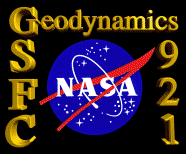
|
Terry Sabaka (Raytheon STX and Geodynamics Branch) is a principle architect
of the GSFC/DSRI magnetic Comprehensive Model (CM). This model uses satellite
and surface data to simultaneously represent the contributions from the core,
crust and external (ionospheric and magnetospheric) fields. It is the
state-of-the art description of the near-Earth magnetic field. And it is
finding many fans and a wide variety of uses in the community. The figure
(right) shows one example: merging local aeromagnetic surveys done at
different times and at different altitudes. Former attempts using simpler
global field models resulted in disconnects across survey boundaries. But
Ravat and co-authors show in a recent “The Leading Edge” article, the CM’s
superior representation of the changes in the Earth’s field greatly improves
the ability to stitch such surveys together. The model is available in
web-based form. Improvements continue, and the most recent version, CM4, was
recently submitted for publication.
|




![]()
![]() Back to Geodynamics Science Highlights
Back to Geodynamics Science Highlights